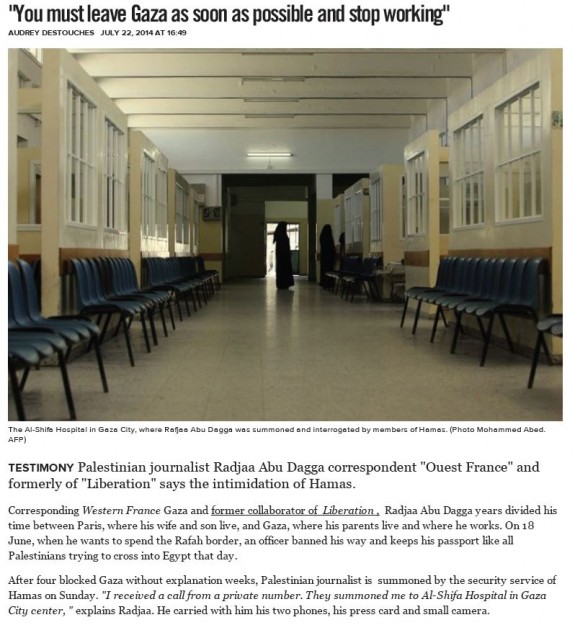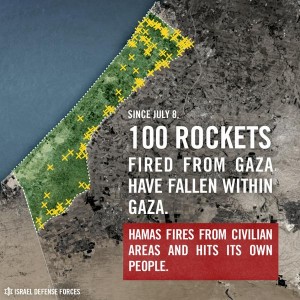| Shifa Hospital in Gaza |
The idea that
one of Hamas’ main command bunkers is located beneath Shifa Hospital in Gaza
City is one of the worst-kept secrets of
the Gaza war. So why aren’t reporters in Gaza ferreting it out? The precise
location of a large underground bunker equipped with sophisticated
communications equipment and housing some part of the leadership of a major
terrorist organization beneath a major hospital would seem to qualify as a
world-class scoop—the kind that might merit a Pulitzer, or at least a Polk.
So why isn’t the
fact that Hamas uses Shifa Hospital as a command post making headlines? In
part, it’s because the location is so un-secret that Hamas regularly meets with
reporters there. On July 15, for example, William Booth of the Washington
Post wrote that
the hospital “has become a de facto headquarters for Hamas leaders, who can be
seen in the hallways and offices.” Back in 2006, PBS even aired a documentary
showing how gunmen roam the halls of the hospital, intimidate the staff, and
deny them access to protected locations within the building—where the camera
crew was obviously prohibited from filming.
Yet the confirmation that Hamas is using Gaza City’s biggest hospital as its de
facto headquarters was made in the last sentence of the eighth paragraph of
Booth’s story—which would appear to be the kind of rookie mistake that is known
in journalistic parlance as “burying the lede.”
But Booth is no
rookie—he’s an experienced foreign reporter, which means that he buried the
lede on purpose. Why? Well,
one reason might be that the “security sources” quoted whenever the location of
the Hamas command bunker is mentioned—which, as evidenced by this 2009 article by
the excellent and highly experienced foreign correspondent Steven Erlanger of
the New York Times, happens every time there’s
a war in Gaza—are obviously Israelis, not members of Hamas. It might be hard to
believe the Israelis, the simple logic might run, since they obviously have an
investment in arguing that Hamas is using hospitals and schools as human
shields.
The Israelis are
so sure about the location of the Hamas bunker because they built it. Back in 1983, when
Israel still ruled Gaza, they built a secure underground operating room and
tunnel network beneath Shifa hospital—which is one among several reasons why
Israeli security sources are so sure that
there is a main Hamas command bunker in or around the large cement basement
beneath the area of Building 2 of the Hospital, which reporters are obviously
prohibited from entering. (Watchman comment: why didn't the Israelis destroy the command bunker when they left Gaza?)
Hamas obviously has no interest in having a
photo-layout of one of its command bunkers beneath Shifa Hospital splashed on
the front pages of newspapers. After all, such pictures would show that the
organization uses the sick and wounded of Gaza as human shields while launching
missiles against Israeli civilians. What Hamas wants is for reporters to use
very different pictures from Shifa—namely, photos of Palestinians killed and
wounded by Israelis, which make Palestinians look like innocent victims of
wanton Israeli brutality.
To that end, the
rules of reporting from Shifa Hospital are easy for any newbie reporter to
understand: No pictures of members of Hamas with their weapons inside the
hospital, and don’t go anywhere near the bunkers, or the operating rooms where
members of Hamas are treated. While reporters can meet with members of Hamas
inside the hospital—because it’s obviously convenient for everyone—they are not
allowed to take pictures. Reporters inside Gaza who are risking their lives to
bring the world whatever news they can should hardly be blamed for obeying
Hamas’ media rules, which the organization has helpfully written
down in case anyone has doubts about what they are permitted to show.
Reporters who
bravely or foolishly violate Hamas’ rules even on their social media accounts
can be seen to repent with such alacrity that it’s not difficult to imagine how
scared and dependent they are. Nick Casey of the Wall
Street Journal, for example, tweeted that “You have to wonder w the
shelling how patients at Shifa hospital feel as Hamas uses it as a safe place
to see media.” Casey then quickly deleted his tweet, which didn’t save him from
being put on a list of
journalists who “lie/fabricate info for Israel” and “must be sued” – a threat
which is surely the least of Casey’s fears.

Last week, French-Palestinian
journalist Radjaa Abu Dagg was summoned to Shifa by Hamas and interrogated. He wrote about
the experience of “attempted intimidation” for Liberation—and
then quickly had the paper take down the
article.
It can hardly be
lost on any sane journalist that tempers in combat zones can be short, and that
Hamas has used the kidnapping of foreign journalists like Alan Johnson of
the BBC to advance its own agenda. The fact that Hamas has closed the
border and will not let journalists in or out of Gaza can’t make journalists
who being used as de facto human shields by a terrorist organization feel any
more eager to offend their hosts.

What Hamas has done, therefore, is to turn
Shifa Hospital into a Hollywood sound-stage filled with real, live war victims
who are used to score propaganda points, while the terrorists inside the
hospital itself are erased from photographs and news accounts through a
combination of pressure and threats, in order to produce the stories that Hamas
wants. So if reporters aren’t entirely to blame for participating in this sick
charade, then who is?
The answer is that reporters write what
they can, and some do their job better than others, and some are braver or more
foolhardy than their peers. But it’s the job of editors, sitting thousands of
miles away, at a very safe distance removed from the battlefield, to note that dispatches
were produced under pressure, or that key information was removed by a
government—as nearly all mainstream media outlets do when battlefield
dispatches pass through the hands of the IDF censor. A good editor might attach
similar notes to dispatches from combat zones controlled by terrorist
organizations. He or she might also decide that reporting only the news that
Hamas deems fit to print from Shifa Hospital isn’t actually reporting at all:
It’s propaganda.

As the death
toll of Operation Protective Edge rises, the deaths of children are firmly in the
spotlight—and rightly so. It pains all reasonable people to hear of children
dying as the consequence of war. Hamas and its supporters display gruesome
pictures of dead and wounded children in order to gain sympathy for their
portrait of Israel as the villain intent on killing Palestinians. In response,
Israel cites the need to stop Hamas from firing thousands of rockets at its own
children, who are being forced to live in bomb shelters, as well as the need to
eliminate the tunnels that
Hamas dug into Israel in order to carry out terror attacks against Israelis.
One tunnel opening was found underneath an Israeli kindergarten.
But who built
those tunnels? The answer is Hamas, of course—using some of the same children
who are now trapped under fire in Gaza.
The Institute
for Palestine Studies published a
detailed report on Gaza’s Tunnel Phenomenon in the summer of 2012. It reported
that tunnel construction in Gaza has resulted in a large number of child
deaths.
“At
least 160 children have been killed in the tunnels, according to Hamas
officials”
The author, Nicolas Pelham, explains
that Hamas uses child laborers to build their terror tunnels because, “much as
in Victorian coal mines, they are prized for their nimble bodies”.
Human rights
groups operating in Gaza raised concerns about child labor in the tunnels as
far back as 2008. Hamas responded by saying it was “considering curbs.”
Following Operation Cast Lead in 2009 Hamas softened its position
and the Interior Ministry established the Tunnel Affairs Commission (TAC)
which, “In response to public concern at a rising toll of tunnel casualties,
particularly of child workers…issued guidelines intended to ensure safe working
conditions.” No mention is made in the report of the conditions that would
result for both Palestinian and Israeli children from building tunnels that
would be used to launch terror attacks.
Nor does it seem that Hamas paid much
subsequent attention to ensuring the safety of the child workers that it used
to build the tunnels that would wind up endangering the lives of many in Gaza.
On a tour of the tunnels in 2011, Pelham noted that, “nothing was done to
impede the use of children in the tunnels.”
Not only are
Hamas misappropriating much
of the humanitarian aid supplied to Gaza—800,000 tons of cement were used to
construct the terror tunnels into Israel—they are also directly exploiting and
endangering Gaza’s youth in their construction and operation.


No comments:
Post a Comment